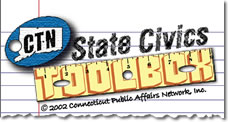|
|
CT-N Legislative Session Click Here for the Word Document version of this page. |
Video Session: Use an appropriate taped CT-N session of the Connecticut House of Representatives or Senate discussing a bill with clearly defined party arguments. Check our Hot Topics page for ideas.
Content: This interactive writing and discussion activity will engage students in the study of bias as it is used in political debate and decision making, and enable them to evaluate the presentation of material and its importance in making informed decisions. This activity is also a good CAPT preface.
Additional Materials Needed:
- Research materials/library time for research on given topic
Class Time: Four to six class periods.
Objectives: Students will: identify bias, evaluate differing viewpoints, draw conclusions, and demonstrate an overall understanding of the influence of presentation on voter decision making.
Activity:
- (Day one/day two depending on length of video) Introduce topic to class by showing selected clip of legislative debate. Have the class take notes to help them decide which side of the issue they will each decide to stand on.
- (Day two/day three) Solicit initial student response to debate. Have each student select a position either for or against the given topic, or determine which side they will take in another fashion that fits the needs of the individual class. Use balance of class time to explain that each student will write a speech to "present" on the legislative floor on the topic, and to have students begin their own research into the topic. Homework: Research topic.
- (Day three/day four) Utilize resources to finalize research on topic. Write speech for or against topic. Students should have what they consider a final draft ready for the next day's class.
- (Day four/day five) Break class into groups of three or four based on both individual strengths and position on the topic. Groups read each others speeches, employ peer criticism to improve pieces to be turned in following day, and select the one speech out of their group that they want to represent them on the "floor" tomorrow. Homework: Complete changes to speech to be turned in tomorrow.
- (Day five/day six) Students selected the day prior present their speeches to their "legislative peers." The "legislative body" should take notes on each speech, emphasizing the points their peers are using, and the manner in which they are presenting their position.
Whole group discussion on what has transpired. Sample questions follow:- How was similar/ same information used by different people?
For different purposes? - How was material presented to reach differing conclusions?
- What is bias? Why does it exist? Is it always a negative thing? Is it
always obvious? Subtle? - Can bias be avoided?
- Are people consistently aware of their biases? What about the politicians
on the tape? - How can voters deal with this inevitable presentation issue?
- What filters can voters use to see through bias?
- How does the issue of bias tie in with the speeches you wrote? What if
you had been asked to write a persuasive essay? Are these the same
thing?
- How was similar/ same information used by different people?
Final Cumulative Activity:
- Collect the speeches each student has written; grade using CAPT-style rubric and return to students. Use opportunity to extend learning by examining how and where they used bias to create a persuasive essay.
- Teacher Notes: Instead of writing speeches, students could also be asked to write a letter to their representative either supporting or disagreeing with the measure.
- Consider logging an index to the videotaped session ahead of time as a reference. Include name of representative, any amendments offered and position on issue.
- Day 5/6 can be treated as a mock legislative session to whatever degree is comfortable for the class.
Debrief/Closure: Bring the class together as a whole and discuss the following
Key issues/ questions:
- Can bias be avoided?
- Can the same information be used by different people for different purposes?
- Is it possible for voters to filter out bias in order to make more informed
decisions?
Enduring Understandings:
- The same information can be used to reach very different conclusions.
- Bias is an ever-present factor in both the presentation and evaluation of material.
If you have any comments or suggestions about this activity or would like to submit your own activity, please contact us and share your ideas.
